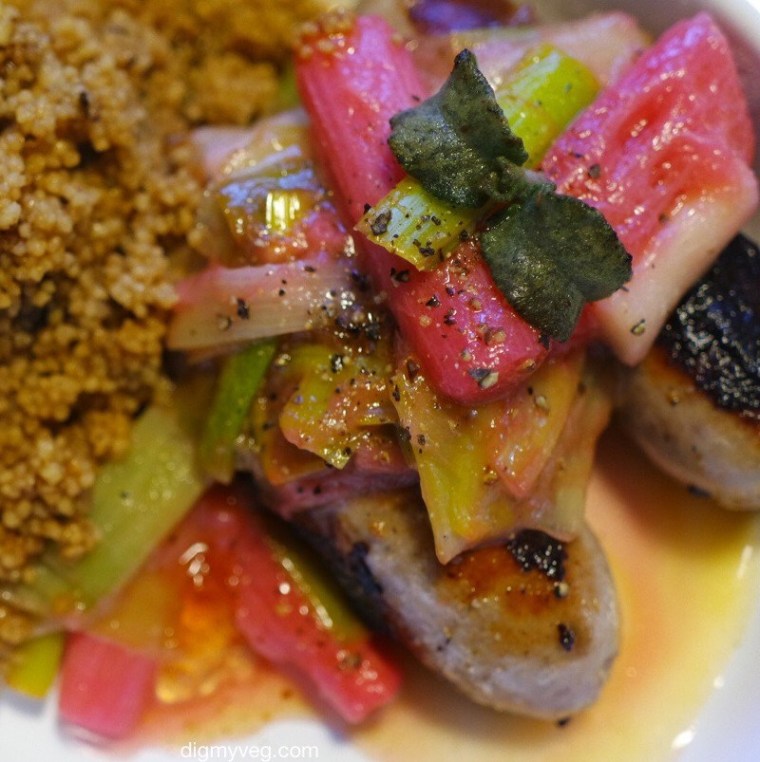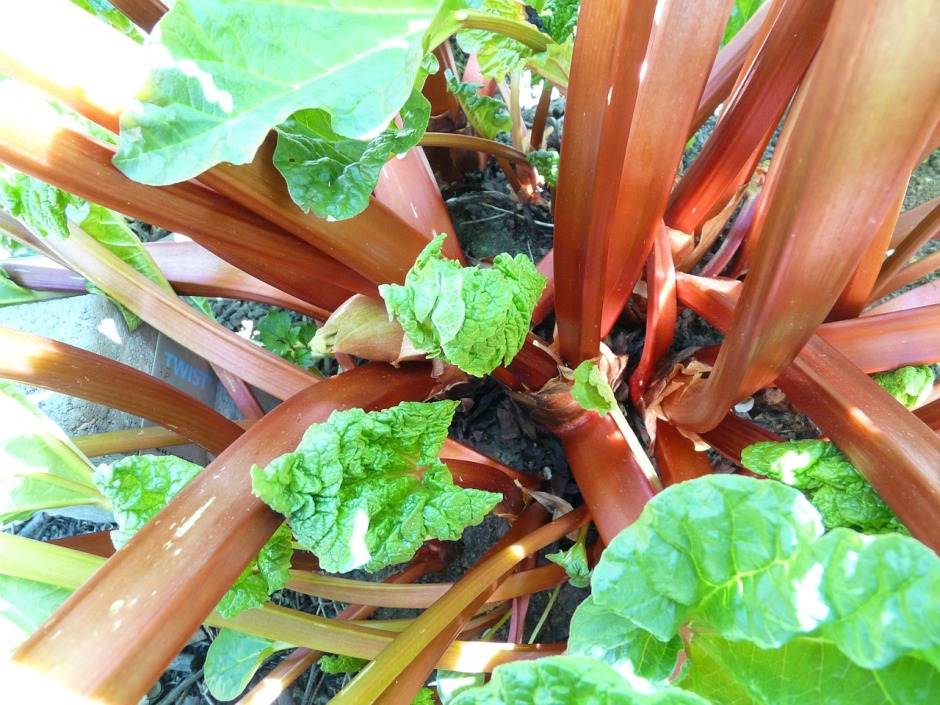Every year between January and March, an agricultural tradition takes place in a nine-square-mile area of Yorkshire.
In large dark barns between Wakefield, Morely and Rothwell, slender pink stems of forced rhubarb are hand picked in a hushed candlelit environment. It is an agricultural act of romance.
The area known as the rhubarb triangle used to be much bigger. At one point it produced 90% of the worlds forced rhubarb. Production declined following the end of World War 2, as a rationed-out British public lost the taste for rhubarb – a crop that served them so well during the war – for more exotic fruits and vegetables that had become more accessible.
It pleases me greatly to discover rhubarb has enjoyed a revival. In February 2010, Yorkshire Forced Rhubarb was awarded Protected Designation of Origin (PDO) status by the European Commission’s Protected Food Name scheme after being recommended by Department for Environment, Food and Rural Affairs (Defra).
Forcing rhubarb produces an earlier, longer stemmed and more tender crop. In allotments and kitchen gardens, rhubarb can be forced like within the sheds of Yorkshire. Traditionally a terracotta pot is placed over the crowns in December to eliminate all the light from the plants. Forcing can be accelerated by heaping manure or garden compost around the forcing pots to produce heat. It will take its toll on the rhubarb so it’s important not to force the same crowns year after year.
Cultivation
I took up an offer from Grow your own magazine and bought two rhubarb crowns from D.T Brown. One variety is Raspberry Red AGM the other is Valentine. Between them, these crowns should provide us with plenty of beautiful rhubarb stems for years to come.
Rhubarb will grow pretty much in any soil but it’s much more beneficial to plant in well-weeded beds that have plenty of manure or compost incorporated into it. It’s a perennial, and once you have planted it or inherited it, you have it for good. One or two plants should be enough for most people and if you have more than one, plant the crowns in their bed 3ft apart. Make sure the plants are well watered during their first season.
Rhubarb likes a feeding of nitrogen in the spring so provide a top dressing of pelleted chicken manure or well-rotted farm manure. Don’t apply it directly on the plants as this can lead to rotting.
It is extremely important not to give into temptation and harvest any of the rhubarb stems in the first year. We must be patient and wait until the second year before we harvest rhubarb stems, and even then only harvest lightly. The crowns need this time to establish and harvesting them prematurely will result in weak plants and could kill them off.
Harvesting
Pull the stems from the base of the plant with a downward motion and a little twist. On established plants take what you need but leave what common sense suggests, so not to rob the plants of too much. Harvest until mid-summer and then leave them alone to regain their energy for the next year.

Aftercare
Rhubarb plants should be divided every three to four years as they can become congested and weak. The bonus of having to divide the plants is more plants for free!
When it comes to dividing, dig the plants up in the autumn and use a sharp spade to split them into sections. Make sure each section has, at least, two healthy buds and replant the divided sections straight away.
Uses.
Rhubarb reminds me of Sunday dinners at my grandparents. Their garden was mostly rows of vegetables and during the spring and early summer, rhubarb crumble was the desert of the season.

Most commonly, rhubarb stalks are stewed with sugar and used in pies and crumbles, but there are so many other ways of using it.
Delia has a lovely light recipe for Rhubarb Yoghurt Fool and a there’s also luxurious Rhubarb Meringue Pie from the BBC.
On the Blogs
Horticulture Hobbit’s blog has delightful rhubarb offerings in the form of jellies and Vodka. Hic!
On a cold and dreary day in January, Heroutdoors Jane Merrick was cheered by the news her local grocer had got in some Yorkshire forced rhubarb. Jane likes it as much as she likes the sounds of A-ha and made it her Star of the Week.

Now, in an incredible twist of inspiration, Judy Bown over on Dig My Veg takes it to a new, no-rules-level and combines rhubarb with leek. Take to the culinary dance floor and perform the Leek & Rhubarb Tango!

Finally, rhubarb doesn’t just have culinary uses. As I scoured old gardening books I read of gardeners placing a piece of rhubarb in the hole before planting their brassicas. Apparently it keeps the clubroot bacteria away. I have no idea if this works.
I do recommend you take a trip over to Home allotment. Richard and Simon have some fantastic advice for homemade organic insect and pest sprays, including one using rhubarb leaves.
If you are a long-term rhubarb grower or like me, planting the first crowns for a supply for years to come, I would love to hear from you. Any tips and advice are always gratefully received. Drop me a comment below or connect with me on Twitter, Instagram and Pinterest.








Thank you for the fabulous link, Richard! …
(PS it’s Bown, not Brown..!)
LikeLiked by 1 person
Oh Judy I’m so sorry. Tired eyes again. Will correct.
LikeLike
Honestly,no need to apologise… it happens all the time! It would be easier to change it to Brown (or to the original De Bohun, which sounds much more interesting… I could go on the stage…)
LikeLiked by 1 person
Wow that really would be an a lister name to behold on the theatre road! 😊
LikeLiked by 1 person
Thanks for the mention in you excellent blog on rhubarb. As a Yorkshire man, I have always loved the forced rhubarb and I am forcing some outdoor now. My Dad has been in the sheds near Morley and he always said you could hear them growing. The leaves busting open
LikeLiked by 1 person
Gosh, that sounds quite… passionate!
LikeLiked by 2 people
Richard you are more than welcome. I really enjoyed your post on the insect sprays. You will clearly be the man to seek some advice from when it comes to managing our rhubarb patch! I remember watching a documentary or news segment on the sheds in Yorkshire. A lady said the same thing that you can stand in those forcing sheds in silence and hear the rhubarb grow. I would love to experience that.
LikeLiked by 1 person
A great, entertaining post Richard… very well done 🙂
I guess the insect and pest sprays use the leaves because they are very poisonous? I imagine a stout pair of Marigolds and a pair of goggles would be advisable in its use as a spray?!
LikeLiked by 1 person
Yes. Richard does put some stout warnings on the blog regarding the toxicity of the rhubarb leaves.
LikeLiked by 1 person
Thank you for the kind comment. I rather enjoyed writing this post even though I will have to be patient gardener before enjoying the crop!
LikeLike
An interesting, and informative, post. I grow rhubarb but I have to say that it’s not something I’m really fussed about eating. In the autumn I always cover mine with a ‘duvet’ of compost and wood chippings for the winter. The latter I remove once new growth appears in the spring.
LikeLiked by 1 person
Thanks Mike. I like that description of tucking them up for winter under a ‘duvet’
LikeLike
A very good and thorough blog post. I’ve got a new Rhubarb to plant but the weather is not playing ball. (Raining). Do you use the grow your own mag forums..? If so, I’m seasprout. 🙂
LikeLiked by 1 person
Thanks so much. I really enjoyed writing this post – learned a lot. Shame we cant enjoy the rewards for a year. I have been to them once or twice. Planning to use them much more. Will look you up!
LikeLiked by 1 person
Thanks for a great informative post! I’ve had an allotment for a year and it’s very much a work in progress. I inherited some tasty rhubarb. (and thanks for the follow over on @CraigentinnyTel)
LikeLiked by 1 person
Hi Sandra! Great hearing from you. Thanks for the kind comment 😊
I know how it feels. I’ve learned a lot through this process already. I try and focus on the positives and I really think it has been important to take it in manageable steps. I tell myself the allotment isn’t going anywhere and I feel satisfied doing each step as well as I can. I have managed to get quite a bit developed since last December and compared to the first year I had the plot it’s felt much more manageable since stepping back, having a plan and then carrying each part of the plan out.
Good look with the allotment. Really look forward to hearing how it’s going 😊
LikeLike
I inherited 2 rhubarb crowns on my first year st the allotment last year. I put them in the ground and forgot about them. The slugs munched on the leaves and the weeds grew around them.
At the weekend I moved the crowns to a much better place – next to the strawberries and raspberries! I will look after them and hope to have some delicious stalks this year.
I was never overly fussed about rhubarb, but I can’t wait to have my own vivid, pink stalks to cook with. Thanks for the recipe suggestions!
LikeLiked by 1 person
Hi Katrina, thanks so much for the comment.
Hardy little things! Hope the new home makes them very happy – look forward to hearing how they get on. Maybe we can compare the crop next spring!
LikeLike
Great feeling when the rhubarb peeps out again. Saw it first today 🙂
LikeLiked by 1 person
It’s is. Especially following a dark miserable winter. My new plants a poking through. Must not touch though. Looking forward to a few stalks next year 😊
LikeLiked by 1 person
Already had a few stalks of the Timperley Early with custard, but the Champagne is just pocking it’s nose through…
LikeLiked by 1 person